It’s kind of fun to have no idea where I’m going next.
With almost two months before the next sure thing on my calendar (a visit to Denver in December), I had plenty of time for a long international trip. I just wasn’t sure where to go. After running through a list of potential destinations – including Nicaragua, Ecuador, Cuba, Iceland, and England – I decided this was an ideal chance to revisit Patagonia. Five years ago when I looped though southern Chile and Argentina I’d been too rushed to do the full W trek in Torres del Paine, and, frustratingly, I never managed to get a clean look at Fitz Roy, so I still had unfinished business in that part of the world. And the timing would be perfect. Temperatures in Patagonia were just starting to warm up, but it was still early enough that I could get in and out before tourist season kicked into full gear.
My plan took shape pretty quickly. I’d lead off with the W trek, head over to El Calafate and El Chalten, and finish with a few days in Ushuaia.
From San Francisco it took me two plane changes and over 20 hours to get to Punta Arenas, Chile. When I landed I realized I’d set a new personal record in both polar directions this year. In July I made it further north than I’d ever been (Anaktuvuk Pass, Alaska), and now I was further south than I’d ever been. Punta Arenas rewarded me with what turned out to be one of the most colorful sunrises I’d seen all year.
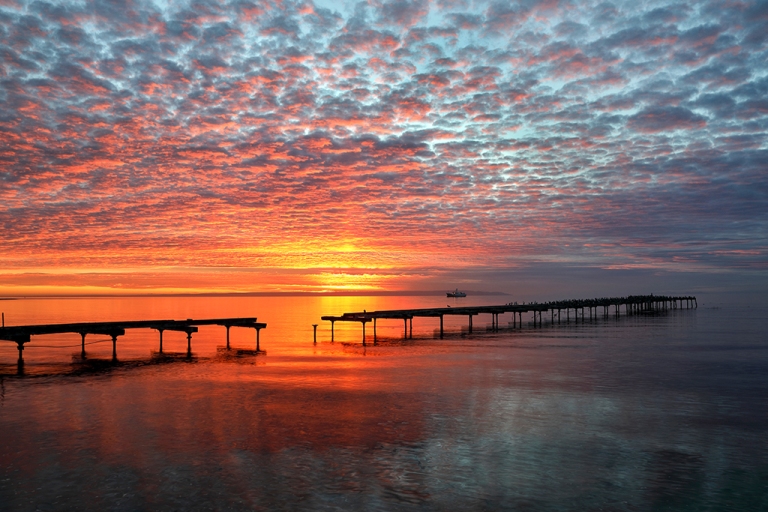
From Punta Arenas I made the short jump to Puerto Natales (the city closest to Torres del Paine), and the following morning I headed straight into the park. Revisiting a place is rarely as exciting as experiencing it for the first time, but the bus ride to Torres del Paine triggered an unexpected upwelling of good memories – not just from my previous trip to the park but from all the traveling I’ve done in Patagonia and all the hours I’ve spent admiring the area’s dramatic, desolate, wind-scoured landscapes. Treasured but faded memories were recalled and renewed in a sudden rush that took me by surprise and affected me even more strongly than the thrill of my first visit.
At the Pudeto stop I hopped off the bus, shouldered my big backpack – inside of which I had my lighter camera backpack – and made the short hike to Salto Grande, a waterfall with a nice view of the park’s central mountains.
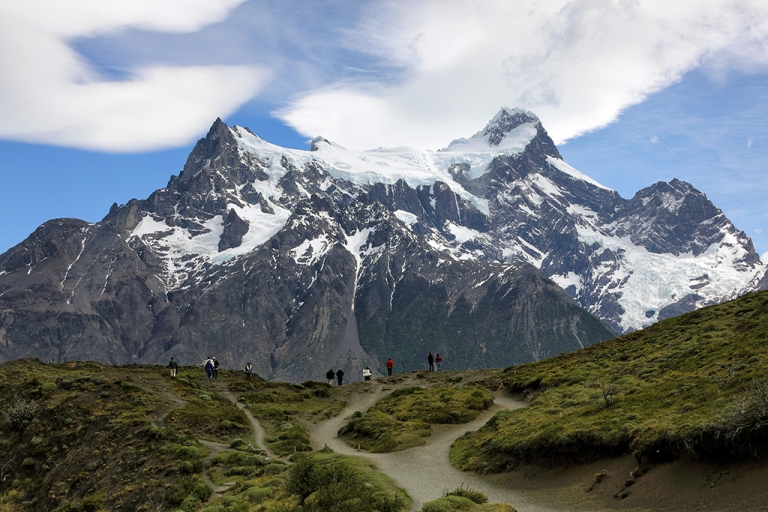

Before starting the W trek I planned to spend a couple nights at Hosteria Pehoe. The hotel, unremarkable except for its location, is distinguished by offering what may be the best view of Los Cuernos – the craggy two-tone mountains in the middle of the Paine massif. And the Torres del Paine photo I coveted above all others was a shot of the day’s first sunlight hitting Los Cuernos. I vowed that if Mother Nature would cooperate on at least one of my two mornings at Hosteria Pehoe I would happily accept whatever weather she sent during the rest of my time in the park.
The walk from Salto Grande to Hosteria Pehoe took about an hour and provided a chance to adjust to my backpack. My feet, legs and back weren’t used to supporting that much weight and I was glad I could break myself in with a short introduction to the heavy load before setting out on the longer W hikes.
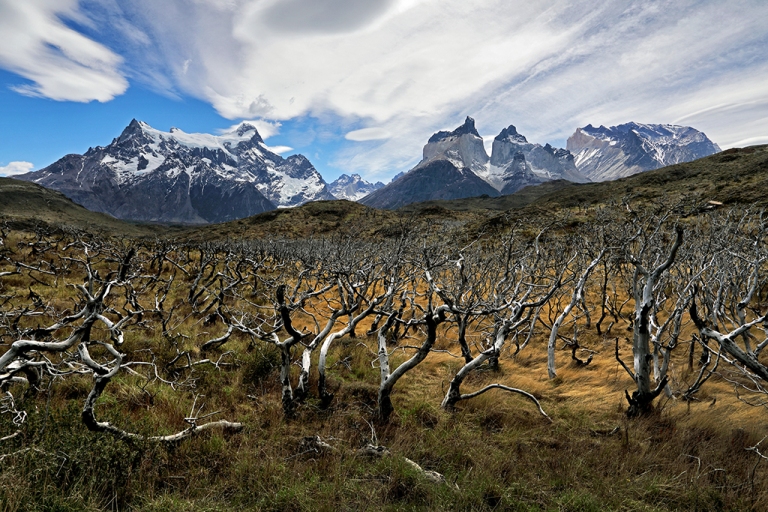
The view from Hosteria Pehoe didn’t disappoint. The hotel is on a small island in the middle of a lake, and at the top of a hill on the west side of the island you can see for miles in every direction. On my first afternoon I took some shots from the hill before scouting locations further south, including the boardwalk trail connected to the luxury Explora hotel.

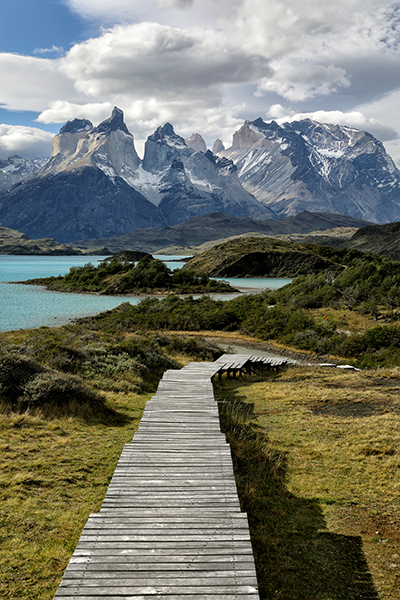

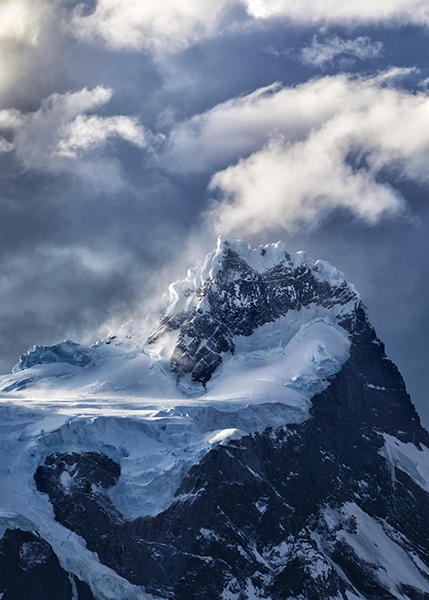
At dinner that night a Chilean named Alejandro Gonzalez introduced himself and presented his business card, which listed “Puma Tracker” as his job title. “That may be the coolest job title ever,” I told him. “So you take tourists out to try to find pumas in the wild?”
“Yes. Maybe on your next visit you hire me.” At the time Alejandro was working for a European mom and her daughter, and apparently they did spot a puma the next day.
The next morning I bolted out of bed before dawn and practically ran up the hill next to the hotel for a better view of the weather. Clouds blocked the sunrise, unfortunately, but a little bit of early light eventually hit Los Cuernos, and some scattered rain showers even conjured up a rainbow.
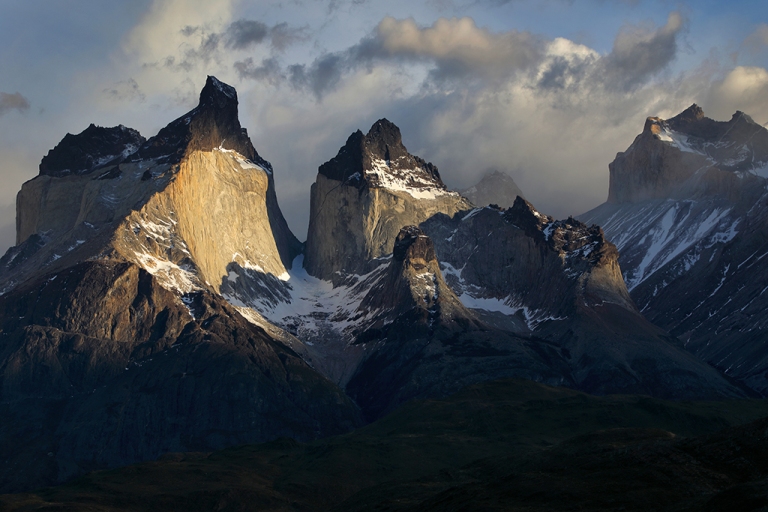

After breakfast I climbed up to a nearby viewpoint called Mirador Condor, where the legendary Patagonian wind was so fierce it nearly knocked me off my feet. The wind is such a strong presence that it’s almost impossible not to personify it, and I may or may not have yelled at it a few times.
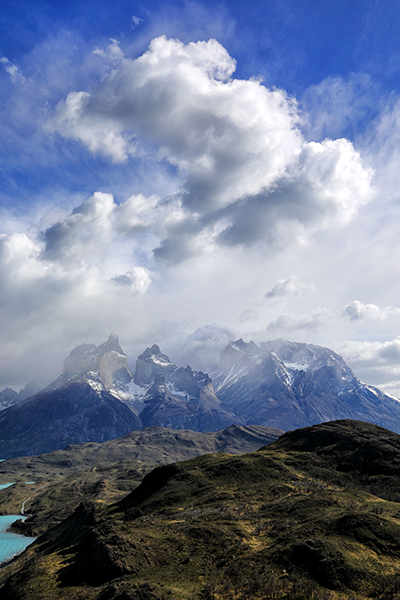
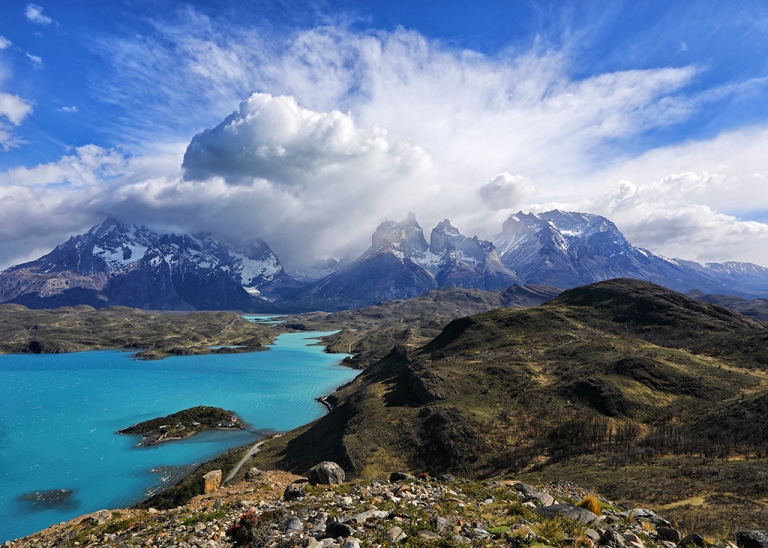
At 5:45am the next morning I crossed my fingers and opened the door of my hotel room. Not much wind, which was a good sign. The eastern horizon looked free of any clouds that might block the sunrise, which was an even better sign. And not only were Los Cuernos fully visible, but a halo of puffy white clouds hovered just above them, perfect for catching early morning color. The conditions were almost too good to be true. I rushed up the hill and couldn’t stop smiling. Slowly the emerging light painted the clouds above Los Cuernos reddish-pink, imperceptibly shifted to soft pastel orange, and finally – after what seemed like forever – the first direct sunbeams of the day lit the peaks of Los Cuernos with a golden yellow glow.
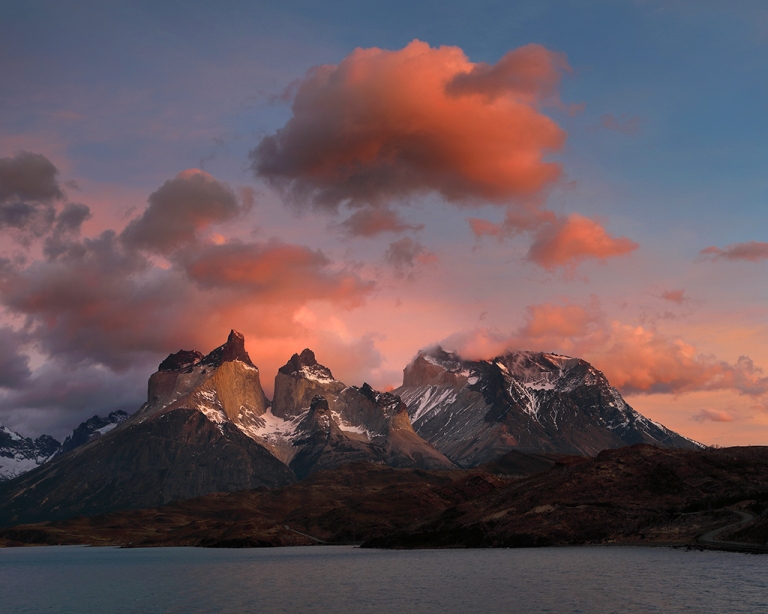
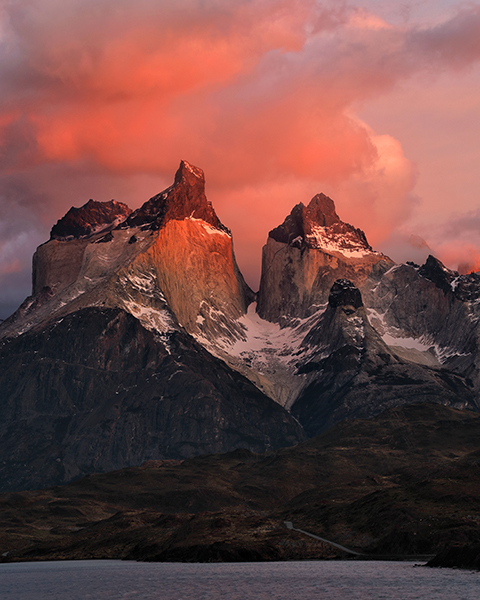
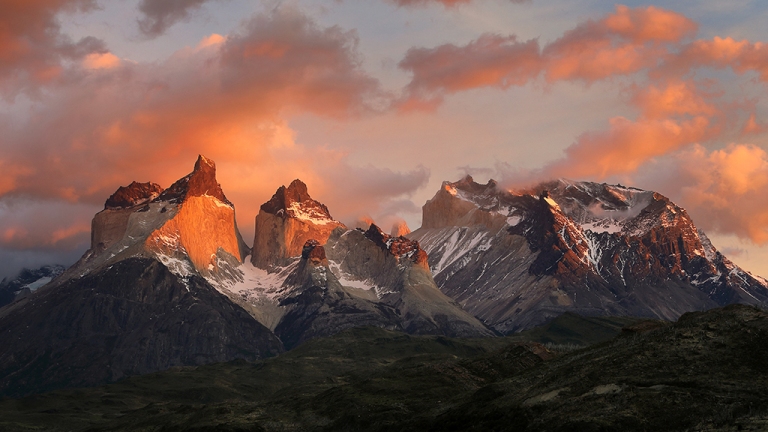
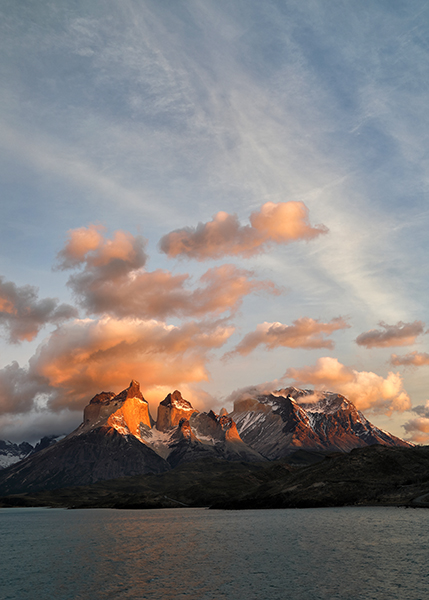
I couldn’t believe my luck. The weather in Patagonia is famously fickle, and on any given day the odds of all the key elements lining up are low. I was incredibly thankful that I happened to be there on such a beautiful morning. Mother Nature really came through for me.

The W trek, named for the shape of the trail, is one of South America’s best hikes. At key points on the trail there are refugios (shelters/lodges) where you can camp or sleep in a dorm room. I didn’t want to bring my camping gear, and even early in the season the dorm rooms fill up fast, so I had to make reservations well in advance and lock in my itinerary for the hike even though I would have preferred to have had more flexibility. Many people do the W in three nights / four days, but I stretched it to a full week to increase my chances of getting good photo conditions.
From my hotel I walked back to the Pudeto stop and caught the Lake Pehoe catamaran to Refugio Paine Grande, the bottom-left point of the W. The views of Los Cuernos from Paine Grande weren’t nearly as good as I’d hoped, but I enjoyed exploring the area and hiking along the lake to Mirador Pehoe.
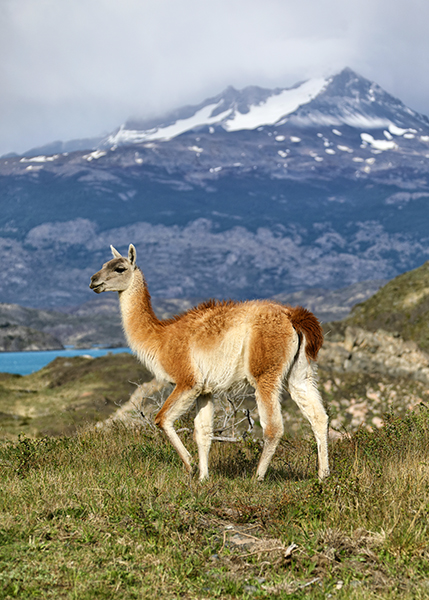


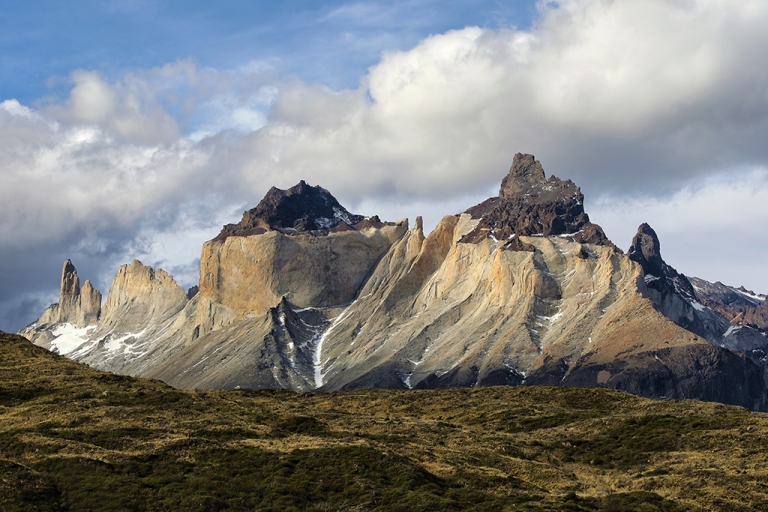
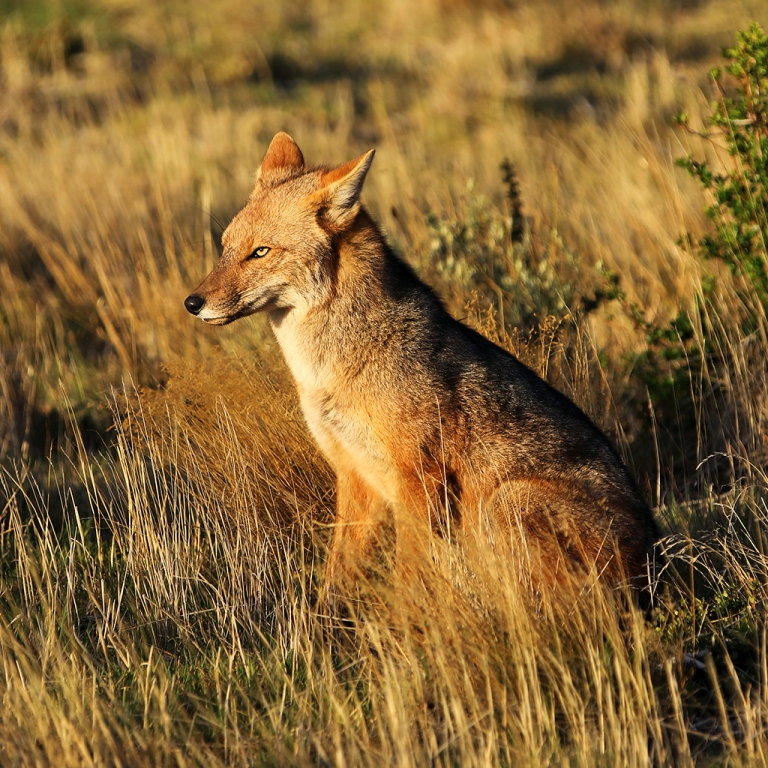
After two nights at Paine Grande I hiked four hours north to Refugio Grey, the upper-left point of the W. From Refugio Grey it only takes about 10 minutes to get to a viewpoint overlooking a massive glacier that calves into Lago Grey. The first sight of it was breathtaking. When I arrived that afternoon hundreds of glittering icebergs – many of them tiny but some as large as buildings – bobbed the small bay beneath the viewpoint.


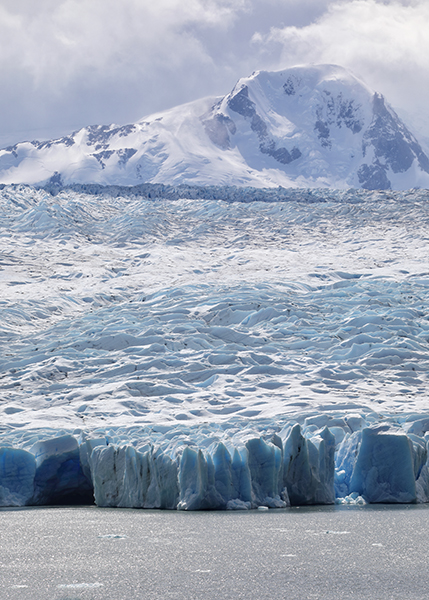

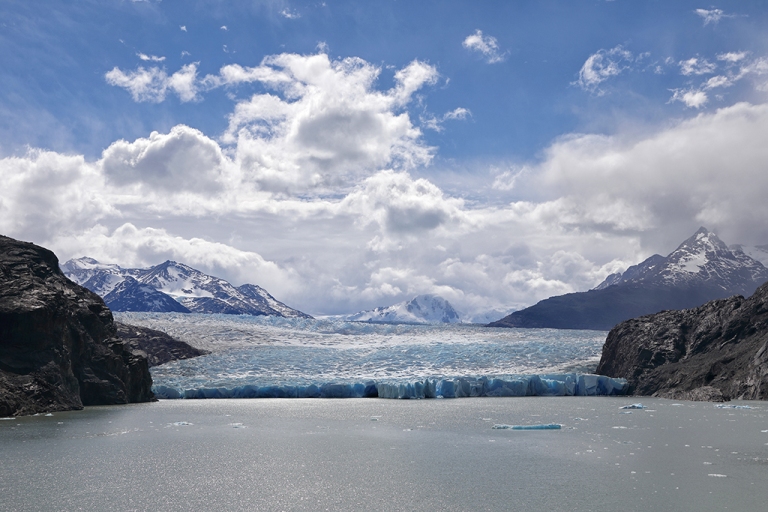
The next morning I returned to the glacier before sunrise, but clouds blocked the early light. After breakfast I hiked back to Paine Grande, straining during the steep uphill stretches and wishing I’d packed less stuff. All things considered my feet, legs and back were holding up OK, but I was glad to have most of the afternoon to rest up for a much longer hike the next day.

This took me straight back. So glad it all worked out — great shots 🙂 🙂 🙂
LikeLike
Breathtakingly beautiful Rob!! This definitely will be on my list. May I ask what kind of camera and lens you used on the trip? It’s backpacking so one can’t bring a heavy duty one unless you’re very fit, and you seem to be able to zoom in some shots with still tack-sharped details, or perhaps cropping on some pictures? That would help me prepare for my trip in the near future. Thanks.
Don
LikeLike
Thanks Don! I used a Canon 5D Mark IV and a Canon 28-300L lens (plus a Gitzo Traveler tripod with a RRS ballhead), which admittedly added a lot of weight to my pack. But given that taking photos is a big part of the trip for me it was worth it. Good luck!
LikeLike
That is a heavy duty load you carried but it’s worth it. With plenty of megapixel for the pictures, all purpose lens and light tripod plus excellent RRS ball head you did a very good job on recording the rare instances of the scenery. Thanks for letting me know.
Don
LikeLike
What a great set of photos!
LikeLike
The Glacier Grey was so beautiful! I am now in Patagonia and I going to Torres De Paine over the next two weeks. I cannot wait to visit after reading your post!
LikeLike